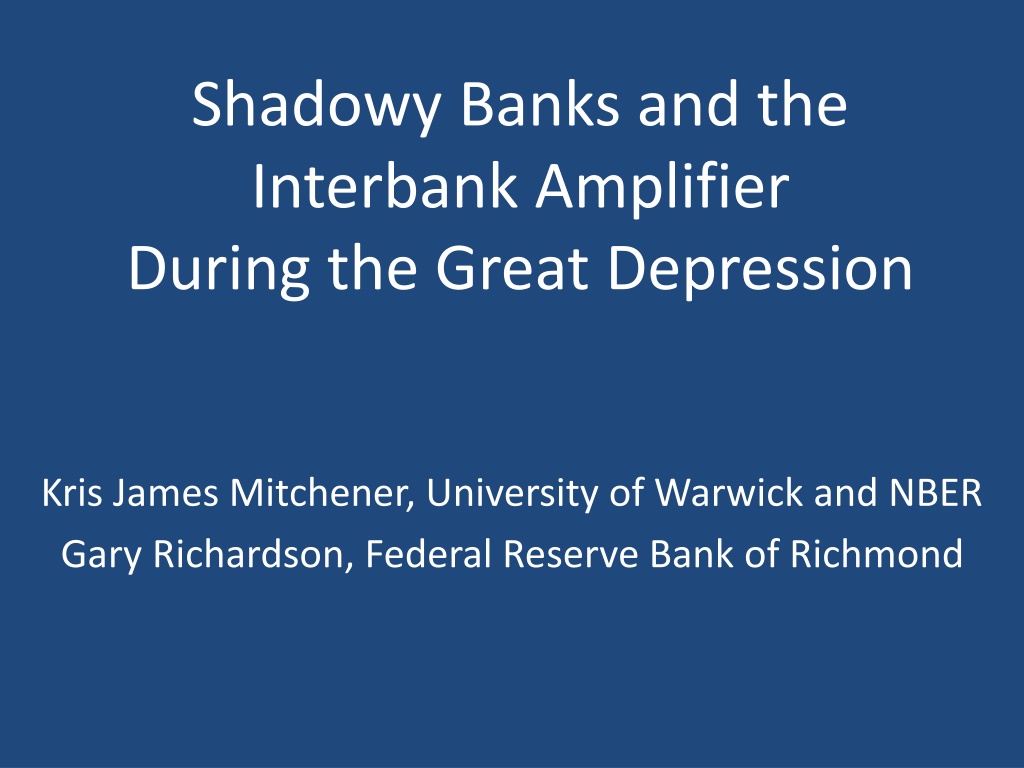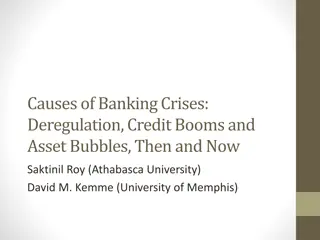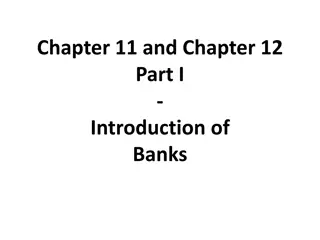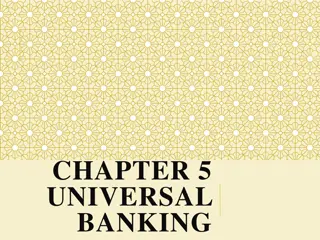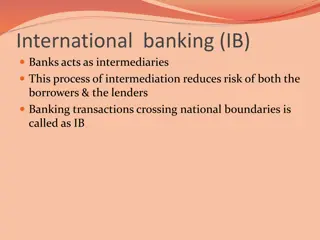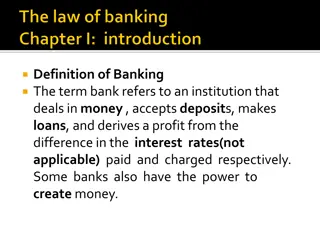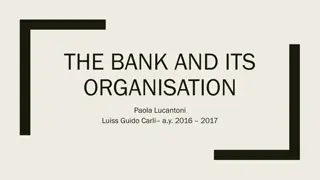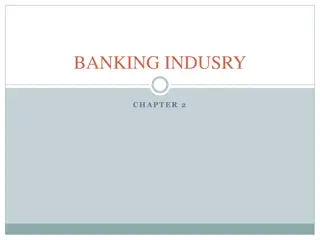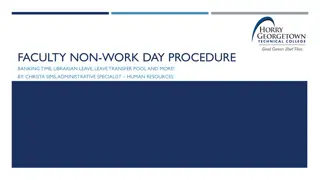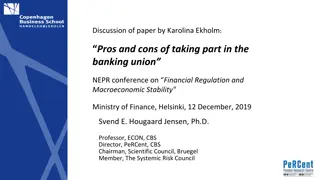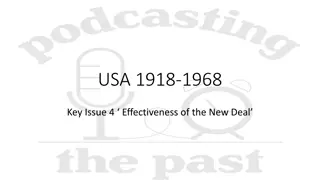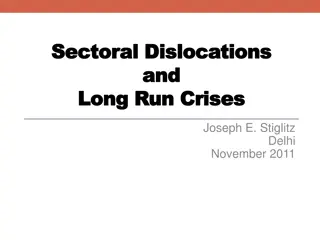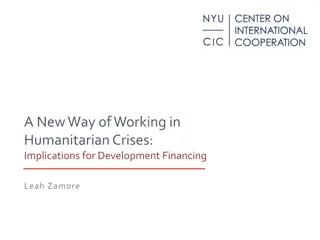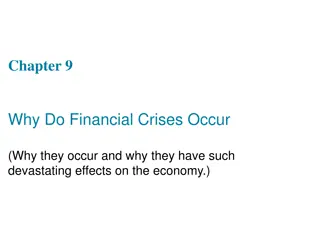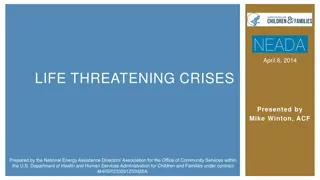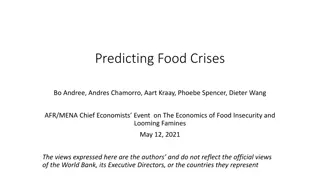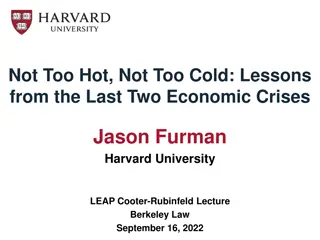Impact of Banking Crises on the Real Economy: Lessons from History
Understanding the influence of banking crises on the real economy, particularly during the Great Depression, where massive bank suspensions triggered economic turmoil. The interplay between banking panics, monetary deflation, bank failures, loss of credit information, and debt deflation worsened the economic downturn. The role of shadowy banks and interbank networks in propagating distress and magnifying credit contraction is highlighted, shedding light on the critical linkages across financial institutions during crises.
Download Presentation

Please find below an Image/Link to download the presentation.
The content on the website is provided AS IS for your information and personal use only. It may not be sold, licensed, or shared on other websites without obtaining consent from the author. Download presentation by click this link. If you encounter any issues during the download, it is possible that the publisher has removed the file from their server.
E N D
Presentation Transcript
Shadowy Banks and the Interbank Amplifier During the Great Depression Kris James Mitchener, University of Warwick and NBER Gary Richardson, Federal Reserve Bank of Richmond
How do banking crises influence the real economy? Look back to the Great Depression Period of massive global banking distress Roughly 10,000 bank suspensions in U.S. alone Those that suffered banking crises fared significantly worse (Bernanke and James, 1991) Seen as one of the major reasons for the depth and duration of the Depression
Friedman and Schwartzs (1953) channel Emphasized banking panics led to a contagion of fear and withdrawals of panicked depositors Bank runs reduced the currency-deposit ratio and monetary aggregates. This monetary deflation led to economic contraction Federal Reserve inaction prolonged the U.S. depression
Bank Lending Channel Bernanke (1983) further suggested failures of banks led to loss of credit information Bank failures raise cost of credit Lending contracts and output falls
Debt Deflation Fisher (1932, 1933), Minsky (1982), and Kindleberger (1978) suggest bank failures contributed to debt-deflation process and therefore decline in economic activity
What about network linkages? Contagion and systemic risk during 2008-9 financial crisis associated with linkages across financial firms Shadow banks (financial institutions outside regulatory purview) feature prominently Like banks: short-term liabilities & long-term assets Linked to commercial banks through credit intermediation chains and correspondent networks Ability to leverage seen as important for fueling housing bubble
Our research What role did interbank networks play in: (1) propagating the banking distress? (2) magnifying the credit contraction? Focus on one possible network channel Linkages arising from interbank deposits Like the modern crisis, we examine the role of financial institutions outside the purview of the Fed, shadowy banks : Non-Fed member commercial banks held deposits in Fed member banks, but were not regulated by the Fed and did not have access to the Fed s discount window
Reserve Pyramid before founding of Fed Central Reserve City Banks Reserve City Banks Country Banks
Interbank deposits after Feds Founding Federal Reserve System Central Reserve City Banks Reserve City Banks Country Banks Fed member banks Shadowy Banks
Shadowy Banks were significant part of overall banking system Non-Federal Reserve member banks were: 2/3rds of all commercial banks Held 1/2 of all deposits How significant were connections to member banks? June 1929: 96% of all interbank deposits were those of non-member banks
The Interbank Amplifier Bank runs ( liquidity shocks ) induce shadowy banks to withdraw their (liquid) interbank deposits from reserve & central reserve city banks Reserve city banks in turn draw down their balances in central reserve city banks Money center banks respond to deposit outflows by reducing their lending to firms and households
Key questions for the interbank amplifier 1. Is there evidence of a link between interbank deposits and banking distress, in particular liquidity shocks? 2. Did reserve-city and central-reserve-city banks change balance sheets change in response to bank runs in country banks? If so, how did they respond? 3. Did the network s reaction affect real economic activity? 4. How large was the overall effect on the economy?
New panel data set Balance sheets for different tiers of the banking system (country banks and reserve and central reserve cities), in each of the 12 Federal Reserve districts Data at call report dates: 1920-33 Roughly quarterly in frequency Supplemented it with information on banking distress and economic activity
On eve of Great Depression Interbank deposits account for: 20% of all demand deposits 60% of aggregate reserves in reserve and central reserve cities Excess Reserves (above legal requirements) were low Interbank deposits multiples greater Member banks could thus meet unexpected declines in interbank balances only by liquidating investments or borrowing reserves from the Fed.
Interbank deposits fall after banking panics of 1930 Figure 2: Interbank Deposits, 1920 - 1932 1000 1500 2000 2500 $1,000,000 500 0 1920 1922 1924 1926\ Date of Call 1928 1930 1932 Central Reserve Reserve Country lpoly smooth: Central Reserve lpoly smooth: Reserve lpoly smooth: Country
Volatility of interbank deposits rises in 1930s Standard Deviation of Interbank Deposits In Millions of Dollars Per Day Central Reserve Reserve Entire US 1924 Dec. - 1929 Oct 2.0 1.6 3.2 1929 Dec. - 1932 Dec. 3.3 2.6 5.6
Little Correlation in 1920s Figure 3: Distress and Deposits, Chicago and Hinterland, 1923 to 1928 0 -10 Change # Banks -20 -30 -40 -100 -50 0 50 100 Change Interbank Deposits, millions of dollars Minneapolis Kansas City Fitted values Fitted values
Correlated with distress of 1930s Figure 4: Distress and Deposits, Chicago and Hinterland, 1929 to 1932 0 -5 Change # Banks -10 -15 -20 -25 -60 -40 Change Interbank Deposits, millions of dollars -20 0 20 40 Minneapolis Kansas City Fitted values Fitted values
Even more pronounced for NYC Figure 5: Bank Liquidation and Interbank Deposits, Nov. 1930 - Dec. 1932 Terminal Suspensions of Non-Member Banks 800 600 400 200 -400 -200 0 200 400 Change Interbank Deposits, Millions of Dollars Chicago New York Fitted values Fitted values
A run on a country bank (liquidity shock) is associated with ~$100,000 decline in reserve city interbank deposits
Key Question 1: some findings Interbank deposit flows for central reserve cities uncorrelated with banking distress in 1920s, correlated in 1930s. Why? Failures in 1920s primarily due to insolvency Country banks insolvent due to farm failures after WWI In 1930s, deposit-driven runs as well as insolvencies Time series results suggest correlation becomes stronger after banking panics begin Liquidity shocks appear to be associated with movements in interbank and public deposits Consistent with both F&S and network channel
Key Question 2: How did central reserve city and reserve city banks respond to outflows of interbank deposits? Examine changes in asset composition: (1) Loans (2) Corporate bonds (3) Government bonds (4) reserves (the sum of the cash in banks vaults and the deposits at the Fed) (5) Interbank deposits ( due from )
SUR Estimates System of equations Changes in deposit flows and asset composition in reserve & central reserve cities Allows us to control for correlation of errors across reserve & central reserve cities
Table 4: Deposit Flows and Asset Allocation, 1929 and 1930 Public Inflow (0.20)* CR*PI -0.44 (0.22)** Public Outflow CR*PO -0.46 (0.25)* Interbank Inflow -0.27 CR*II (0.53)** Interbank Outflow -0.18 CR*IO (0.67)** CR -18.87 (28.89) Constant -5.06 (10.79) F-statistic R2 N Loan Bond-Govt Bond-Corp Reserve Interbank 0.33 -0.07 (0.06) 0.02 (0.07) -0.13 (0.08)* 0.26 (0.08)*** 0.21 (0.15) 0.03 (0.17) 0.28 (0.20) -0.67 (0.21)*** 17.12 (9.21)* -2.57 (3.44) 0.14 0.34 0.13 (0.05)*** -0.10 (0.05)* 0.07 (0.06) -0.05 (0.06) 0.32 (0.11)*** -0.07 (0.13) -0.02 (0.15) 0.02 (0.16) 2.61 (6.98) -1.40 (2.61) (0.12)*** 0.83 (0.13)*** 0.51 (0.14)*** 0.40 (0.15)*** 0.11 (0.28) -0.89 (0.32)*** -0.00 (0.38) 0.04 (0.40) -1.54 (17.34) -0.60 (6.47) (0.04)*** -0.12 (0.05)** 0.20 (0.05)*** -0.15 (0.05)*** 0.49 (0.10)*** -0.47 (0.12)*** 0.40 (0.14)*** -0.38 (0.15)*** 9.78 (6.35) 2.21 (2.37) 0.29 (0.24) (0.47) 1.26 (0.63) 1.65 15.0 0.55 112 8.9 0.42 112 23.3 0.65 112 425.8 0.97 112 16.3 0.57 112 * p<0.1; ** p<0.05; *** p<0.01
Table 5: Deposit Flows and Asset Allocation in Reserve Cities, 1931 through 1933 Loan Bond-Govt Public Inflow -0.17 (0.24) CR*PI -0.22 (0.28) Public Outflow 0.53 (0.11)*** CR*PO 0.01 (0.13) (0.12)*** Interbank Inflow -0.11 (0.47) CR*II -0.03 (0.53) Interbank Outflow 0.06 (0.43) CR*IO 0.31 (0.46) CR -4.37 (31.27) Constant -7.58 (10.02) F-statistic 17.6 R2 0.53 N 140 * p<0.1; ** p<0.05; *** p<0.01 Bond-Corp Reserve Interbank 0.01 (0.23) 0.36 (0.26) 0.05 (0.10) -0.35 0.03 (0.06) -0.03 (0.07) 0.07 (0.03)** -0.16 (0.04)*** 0.00 (0.13) 0.25 (0.14)* 0.14 (0.12) 0.27 (0.12)** 5.06 (8.45) -0.50 (2.71) -0.07 (0.15) 0.98 -0.04 (0.07) 0.07 (0.08) -0.01 (0.03) 0.01 (0.04) 0.61 (0.18)*** 0.09 (0.07) 0.77 (0.08)*** -0.34 (0.30) 0.20 (0.34) 0.05 (0.28) -0.10 (0.29) 27.54 (19.91) 4.55 (6.38) 0.92 (0.45)** 0.16 (0.50) 0.01 (0.41) 0.25 (0.44) -39.01 (29.54) 6.27 (9.47) (0.14)*** -0.80 (0.15)*** 0.58 (0.13)*** -0.52 (0.13)*** 6.97 (9.11) 0.29 (2.92) 6.4 0.29 140 16.4 0.51 140 83.9 0.84 140 7.6 0.33 140
For a single liquidity suspension in 1931-32, how much did assets change? ($1000s) Interbank and Public Deposits, Reserve and Central Reserve Cities, 1931 through 1933 Reserve Interbank Public Interbank Public 1. Deposit Outflows -119 -481 2. Loans -7 -255 3. Bonds Corporate -1 -24 4. Bonds Government -17 -34 5. Reserves -6 -43 6. Interbank -69 Note: Calculations combine coefficients from Tables 2 and 4 as described in text. Calculations reveal average aggregate change in assets of each type among Federal Reserve member banks in reserve and central reserve cities for each liquidity suspension among country banks from 1931 through 1933. Calculations for other time periods use analogous method. Table 7: Liquidity Suspensions Impact on Lending ($ Thousand) Table 6: Liquidity Suspensions Impact on Bank Assets ($ Thousand) through Changes in Central Reserve -183 -481 -68 -48 -8 -260 144 43 -414 9 5 -11 0 Note: Calculations based upon estimates in Table 6 and an analogous (unreported) table for 1929 and 1 30. Lending t o b u s iness i s t h e s u m o f lo a ns a n sheets. Lending to government is the sum of government bonds. The estimates indicate the average change in lending in reserve and central reserve cities in response to the suspension (for liquidity reasons) of one country bank. Columns (1) and (2) indicate changes in lending due to outflows of interbank deposits. Columns (3) and (4) indicate changes in lending due to outflows of deposits from the public. 9 d corporate b o nds h e ld o n b a nks b a lance
Putting the pyramid together Reserve city banks acted as the conduit (-69), transmitting the run of the shadowy non- member bank to the center of the system Respond to distress by removing their liquid assets from New York and Chicago Fed member banks Central reserve city banks have no where to turn Should have been able to go to the Fed if it had acted as a LOLR Instead, they rebalance assets in response
Net decline in lending working across the network When shadowy bank suspended, it induced a $75,000 reduction in lending Roughly 10% of the contraction in lending from reserve cities and 90% in central reserve cities.
How big was the macroeconomic effect of reduction in lending?
Table 9: Aggregate Impact of Interbank Amplifier Compared to Loans and Investments in Suspended Banks (all figures in $ millions) Loans and Investments in Suspended Banks Terminal Interbank Amplifier All Public Response to Country Distress Temporary Liquidity Year 1929 Winter Spring Summer Fall Quarter 1 1 3 2 10 9 26 23 11 11 40 37 3 3 2 2 3 6 21 9 1930 Winter Spring Summer Fall 4 4 3 37 41 32 152 78 93 72 558 18 28 33 196 13 16 10 100 16 1931 Winter Spring Summer Fall 22 24 32 80 56 63 82 209 147 311 496 699 62 228 251 439 23 5 41 291 1932 Winter Spring Summer Fall 40 18 15 16 103 46 38 42 297 230 99 178 145 138 45 65 39 11 18 10 311 1,051 1933 Winter 31 82 234 148 21 Total 3,590 1,833 607 Notes: Loans and investments of suspended banks from Richardson (2008). Interbank amplifier aggregate for each quarter calculated by multiplying the Table 8, Column 7 with coefficients in Table 7, as described in the text
How big was the macroeconomic effect of the interbank amplifier? $311 million reduction in loans & investments (loans & all bonds) In comparison to the contagion of fear F&S: $1.05 billion In comparison to all banks entering liquidation: $3.59 billion May be an underestimate since there are large flows of interbank deposits within certain call reports, e.g. Sep 1931 Too big not to be discussed, especially when we still exclude panic of 1933!
Example, New York, 1933 Jan 4 to Mar 1, 1933 Interbank deposits fell precipitously Regular deposits declined slightly Business lending fell $410 million Government bonds declined $164 million (Episode is missed in call report data) March 1-8 Sold $152 million in government securities Borrowed $449 million from NY Fed
Focus Did interbank deposit flows contribute to the collapse of commercial banking during the Great Contraction from 1929 through 1933? Focus on Reserve pyramid Central reserve cities, New York and Chicago How financial crises on the periphery affected the operation and stability of the financial core.
Literature Review Before Federal Reserve estimated in 1913, reserve pyramid linked periphery and core James 1978, Meyers 1931, Sprague 1910, Bordo and Wheelock 2011, Beckart 1922 During Great Contraction, interbank deposits had little influence on national events. Excluded from analysis. Friedman and Schwartz 1963 Regional panics and policies significantly influenced course of contraction Elmus Wicker 1996. Richardson and Troost 2009. Carlson, Mitchener, and Richardson 2011. Calomiris and Mason 1997. Meltzer 2003. Wheelock 1991.
After Fed Interbank deposits largely From non-member banks Into member banks in reserve or central cities Depositors receive correspondent services Member banks Deposited in Federal Reserve banks and branches Deposits with Fed became principal reserve Fed served as members principal correspondent
Empirical Challenge Task: construct a panel of data across time, regions, and levels of the reserve pyramid Data imperfect Data collection difficult and time consuming
Outline Historical Background Data Methods and Results Interpretation
Data Bank Balance Sheets Call Reports for Fed Member Banks Banking and Monetary Statistics, 1914 to 1941 Call Reports for State Commercial Banks All Bank Statistics, 1896 to 1955 Bank Distress Richardson 2007a, 2007b, etc Federal Reserve Bulletin 1937 Economic Activity by Federal Reserve District Retail Trade by Federal Reserve District, Park and Richardson 2012
